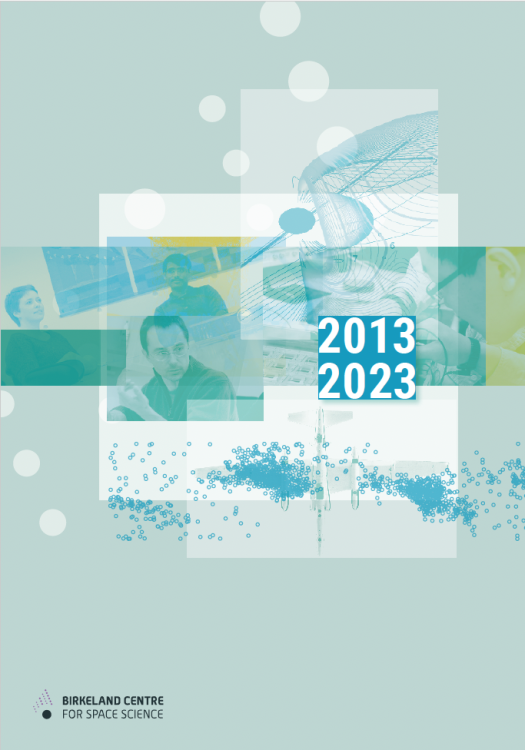CLUSTER
Background
Instruments
Research: Background
Research: 22 August, 2002
Research: Convection
Research: Current Density
Research: Cusp Studies
Research: Discontinuity
Research: Magnetopause Properties
Research: Magnetopause Sounding
Research: Substorms
Publications
Links
The Cluster II mission is an in-situ investigation of the Earth’s magnetosphere.
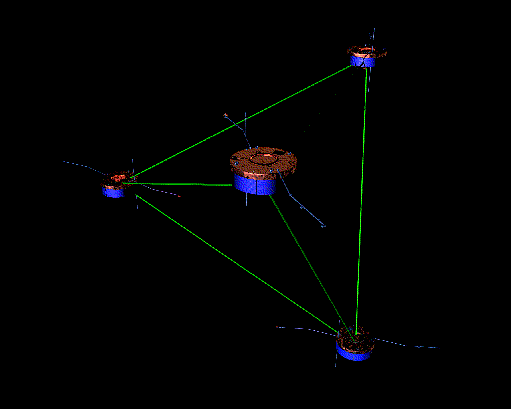
The scientific objectives include to study three dimensional plasma structures in the magnetopause, the polar cusps, the magnetotail and the auroral zones. Because the mission consists of four identical spacecraft, it is possible to distinguish between spatial and temporal variations in the space plasma.
The satellites were launched in July and August 2000. They orbit the Earth in an elliptical polar orbit. Their distance from the Earth vary between 19 000 km (perigee) and 119 000 km (apogee) during their 57 hour orbit period. During one year the location of apogee varies between being at the dayside, the dawnside, the nightside and the duskside.
Research into Adaptive Particle Imaging Detectors (RAPID) is one of eleven instruments onboard the Cluster II satellites.
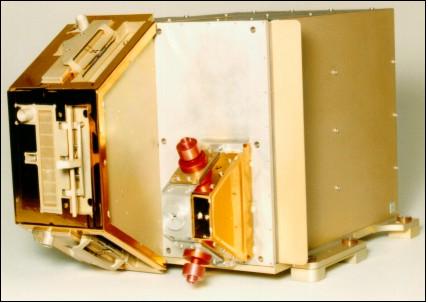 The RAPID spectrometer
The RAPID spectrometer
The RAPID spectrometer is an advanced particle detector which detects energetic electrons and ions.
The RAPID ion spectrometer (IIMS) and the smaller RAPID electron spectrometer (IES) are separated into three units looking in different directions. Each unit is covering an angle of 60 degree.
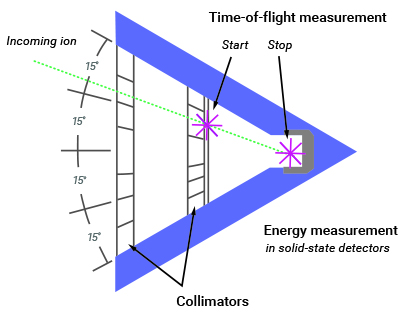 One of three IIMS (ion) Sensors
One of three IIMS (ion) Sensors
During one satellite spin, the intensity of the particles in the area around the satellite is measured. The particle’s directions and energy will be recorded. The ion detector will also register the particle’s mass when combining the travel time (between start and stop on the figure) with the energy measured by the semiconductor.
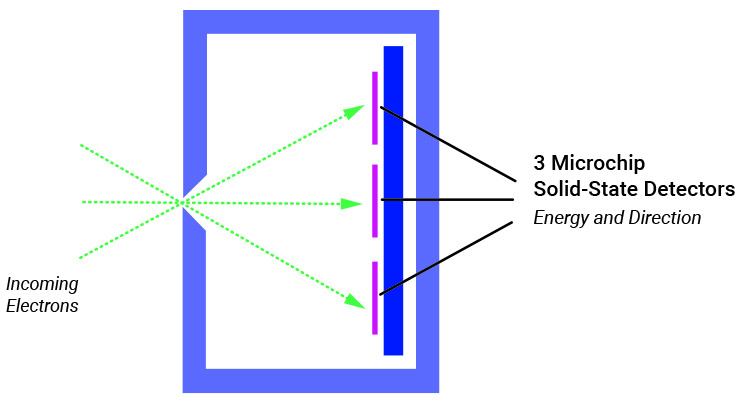 One of three IESS (electron) sensors
One of three IESS (electron) sensors
The Department of Physics and Technology at the University of Bergen has developed and delivered microelectronic circuits for managing and reading of the data from the Rapid instrument. We have also built and delivered equipment, including software, for testing of the instrument.
The Cluster mission is primarily designed to study the three-dimensional extent and the dynamical behaviour of small-scale structures (from a few hundred to a few thousand km in extent) in the Earth’s plasma environment. This implies the study of the physical processes involved in solar wind – magnetosphere – ionosphere coupling, phenomena in the magnetospheric polar cusp, and in magnetospheric storms/substorms.
1.The dayside magnetosphere and the magnetopause
- Magnetopause sounding
- Cusp studies based on combined ground-space observations
- Orientation and Motion of a Plasma Discontinuity
- Properties of the Earth’s magnetopause
- Current Density from Amperes Law
- Magnetotail, substorms and the ring current
In July to September each year the four Cluster spacecraft cross the magnetospheric tail at a maximum distance from the Earth of about 20 Re. This location and spacecraft separation makes it possible to study the source region of auroral particles.
- Magnetospheric substorms
- The August 21, 2002, event
3.The polar cap
- Large-Scale Convection in Earth’s Magnetosphere
Research: 22 August, 2002Secti
We are currently working on a promising continuation of this study. On 21 August 2002 Cluster observed multiple X-lines in the tail. The event occurred during a prolonged period of southward IMF-Bz. This time period was characterized by strong geomagnetic disturbances, with the AE-index continuously above 500 nT for more than 16 hours, occasionally reaching as high as 1500 nT. Around 08 UT on August 21 Cluster was located at Xgsm = -19 Re close to a magnetic reconnection region. Characteristic features at Cluster were initial observations of strong anti-sunward ion bulk flows and southward magnetic field, followed some minutes later by earthward ion bulk flow and northward magnetic field. This indicates that Cluster was initially tailward of the reconnection region, and the reconnection region subsequently moved tailward of Cluster. About 20 minutes later a new X-line, with similar features, was observed by Cluster.
Presently we are using four-spacecraft analysis techniques to find propagation directions of the discontinuities in the magnetic field associated with the flux ropes (Svenes et al., 2003a, 2003b, 2003c). This study will be continued using additional observations and analysis techniques. Since there are clear differences between these two events, a natural extension is to investigate further events to obtain a better understanding of the processes involved. Several new events have already been identified, and based on current experience, it is likely that further cases will be obtained during the coming year. These events will also be investigated with the expectation that an increase in number of cases also will increase the likelihood of obtaining an event where Cluster even enters into the diffusion region associated with the X-line.
Magnetotail data provided by Cluster and the low altitude data provided by the NOAA satellites constitute an excellent combination to study the correspondence between particle boundaries close to and distant from the Earth. Another study will investigate the relation between the solar wind energy input to the magnetosphere (the Akasofu epsilon-parameter), the particles observed in the tail, and the particle energy deposited into the upper atmosphere. By comparing particle boundaries in the tail and in the ionosphere constraints on magnetic field line models can also be obtained.
These results were presented in following presentations:
- Svenes et al., Study of a near-Earth reconnection event based on Cluster measurements, Cluster Tail Workshop, Graz, 2003a.
- Svenes et al., Study of a near-Earth reconnection event based on Cluster measurements interpreted in a global context, EGS 28th General Assembly, Nice, 2003b.
- Svenes et al., Multiple X-lines observed by Cluster in the near-Earth tail, STAMMS-Conference, Orleans, 2003c.
Large-Scale Convection in Earth’s Magnetosphere
A major part of the transfer of momentum and energy from the solar wind to the Earth’s magnetosphere takes place trough magnetic reconnection. A direct consequence of this process is a large scale circulation of plasma and magnetic flux. This is schematically illustrated in Figure 1 below. When the interplanetary magnetic field (IMF) has a southward component reconnection with the Earth’s magnetic field can occur in the subsolar region of the magnetosphere. The reconnected magnetic field lines and the associated plasma are then swept tailward because one end of the reconnected field lines remains embedded in the solar wind flow. Eventually the field lines reconnect again in the magnetotail and are transported back to the frontside magnetosphere, and eventually to the magnetopause, where the process can start over again.
Projected along the magnetic field lines into the Earth’s polar cap, the circulation of the magnetic field lines during southward IMF should produce a two-cell pattern as schematically illustrated in Figure 2.
The convection of magnetic field lines and the plasma attached to them can be measured by spacecraft traversing the polar cap. The Cluster mission was particularly suited for this purpose because it carried an instruments (the electron drift instrument, EDI, developed under the responsibility of MPE) that provides accurate measurements of the convection velocity, while particle instruments are affected by the low plasma density and thus low count rates, and the classical double-probe technique suffers from wake effects caused by cold upstreaming ions from the ionosphere – the ‘polar wind’ .
Figure 3 shows the statistical convection pattern obtained from EDI measurements for a time period of more than 4 years. Each EDI velocity measurement is first checked for stable IMF conditions, and thereafter mapped along the magnetic field lines into the northern or southern polar cap. The results confirm the expected convection patterns for southward pointing IMF (and also for IMF orientations in the ecliptic plane). For northward IMF (not shown), no clear pattern emerges. Under northward IMF conditions, magnetic reconnection is not expected to occur on the frontside magnetopause, and thus the coupling between the IMF and the geomagnetic field is expected to be less effective.
These results are documented in
- M. Förster, S. Haaland, G.Paschmann, J.B.Baker, H.Vaith, J.M.Quinn, R.B.Torbert, Cross-Polar Magnetospheric Plasma Drift as Observedby Cluster EDI: Statistical results, In Proceedings of the Cluster and Double Star Symposium – 5th Anniversary of Cluster in Space, ESA SP 598, 2005
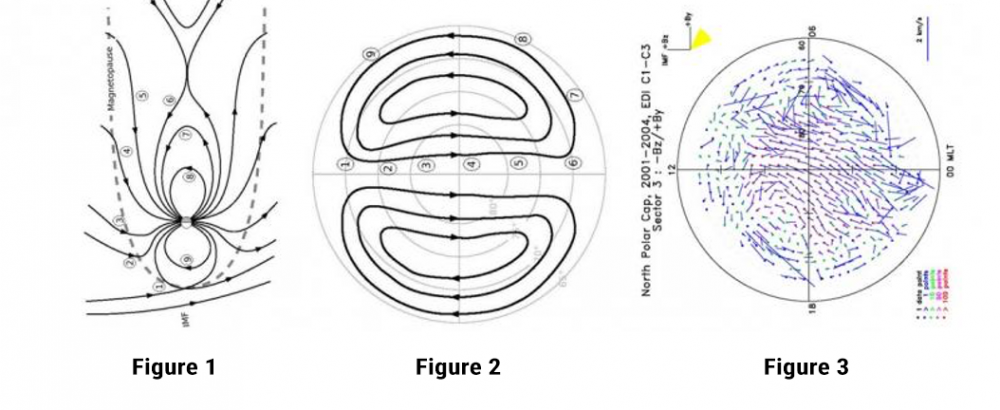
Figure 1: A schematic that shows how a terrestrial magnetic field line that has reconnected with an interplanetary magnetic field line at the subsolar magnetopause is transported along the magnetopause by the solar wind until it reconnects again in the magnetotail to become a closed field line that is convected sunward until it encouters the magnetopause, where the process can start over again. The numbers 1 through 9 label the same field line at different times in the cycle.
Figure 2: When mapped into the Earth’s polar cap, the motions of the magnetic field lines generates a two-cell pattern. The numbers refer to the the mapped position of the field line shown at the times given by the corresponding labels in Figure 1.
Figure 3: Statistics of more than 4 years of convection measurements with the Electron Drift Instrument (EDI) on Cluster SC1, mapped to an altitude of 400 km over the polar cap, for times when the IMF was directed southward to within 45 degrees. The anti-sunward direction of the convection is clearly evident, in agreement with the schematic sketch in Figure 2.
Current Density fro
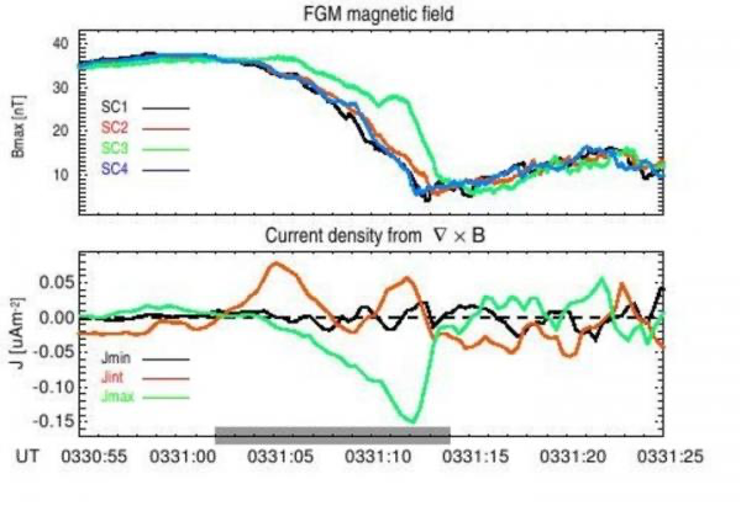
A unique capability of the Cluster mission is the ability to infer local electric current densities through a direct application of Ampère’s law. With measurements from four spacecraft, it is possible construct a gradient operator, and thus solve Ampère’s law. We have tested this method on a number of cases when four Cluster spacecraft crosses the magnetopause – the boundary separating the interplanetary magnetic field and the Earth’s internal magnetic field.
Upper panel: Main component of the magnetic field as measured by the four Cluster spacecraft during a magnetopause crossing on 2 March 2002. Lower panel : the three components, of the current density vector, determined from the differences between the magnetic field vectors at the four spacecraft.
The figure shows an example of a measurements from Cluster during a magnetopause crossing. The four spacecraft were only about 100 km apart in this case. The top panel shows time series of the dominant magnetic field component, as recorded by the magnetometers on the four spacecraft. It changes from a stable value in the magnetosphere (on the left) to a different stable value in the magnetosheasth (on the right). The transitions between the two levels mark the passage of the magnetopause current layer over the four spacecraft. From the differences between the magnetic fields measured at the four spacecraft locations, together with the known specraft separation vectors, one can estimate ∇xB, which according to Ampère’s law yields the current densities. The middle panel shows the three components of the electric current vector, calculated from the curlometer method.
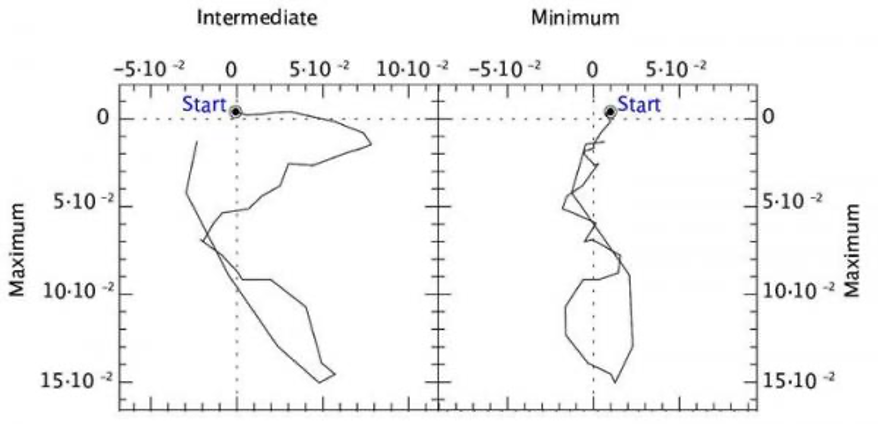
n 6
Hodogram of the current density
It is evident from the three traces in the middle panel that the current within the magnetopause is not uniformly distributed or constant, but highly structured. This fact is better illustrated by the two hodograms shown at the bottom. These hodograms are obtained by drawing all currents measured during the magnetopause traversal as vectors from the origin and connecting the arrowheads by line segments. As they occupy three dimensions, the current vectors have been projected into two orthogonal planes, one (left) being the plane of the magnetopause, the other (right) a plane orthogonal to the magnetopause. From inspection of the hodograms it is evident that the current changes not only in magnitude but also in direction, rotating by almost 180 degrees. The determination of spatial structure of the current sheds new light on the different large-scale current systems closing within the magnetopause.
From the hodogram, one can also infer the magnetopause orientation. Then, by integrating Ampère’s law across the magnetopause current layer, one also obtains the motion of the magnetopause relative to the spacecraft. Since the crossing duration is known (indicated by the shaded bar in the middle panel of Figure 1), the magnetopause current sheet thickness can then be calculated. For this particular case, we found a velocity of about 35 km/s, and a thickness of 160 km, corresponding to 2-3 ion gyro radii.
- Haaland et al. (2004), Orientation and motion of a discontinuity from Cluster curlometer capability: Minimum variance of current density, Geophys. Re. Ltr., doi: 10.1029/2004GL020001
Research: Cusp StudiesSection 7
Cusp studies based on combined ground-space observations:
The optical observations from Svalbard is the basic element in our program of describing and understanding the spatio-temporal structure of the dayside aurora in terms of solar wind-magnetosphere interaction processes. The emphasis has been placed on the establishment of the ionospheric response to magnetopause reconnection events. An important task for the immediate future is the study of reconnection topology and the detailed evolution of magnetopause reconnection events. This is an important element in the process of understanding solar wind-magnetosphere coupling, which is a major task in magnetospheric physics. The focus is on multi-instrument and multi-point observations of spatio-temporal structure in the cusp region. Spacecraft observations (Cluster, Polar, NOAA and DMSP) have been and will be combined with the continuous ground observations of the aurora and plasma convection. The latter observations represent a critical element in the continuous monitoring of solar wind-magnetosphere coupling processes.
Research: DiscontinuitySection 8
Orientation and Motion of a Plasma Discontinuity : Generic Residue Analysis of Cluster Data
Each of the four Cluster spacecraft carries a comprehensive set of instruments for both plasma and field measurements. This can be utilized in a number of different ways for discontinuity analysis. In particular, the quality of some of the higher order moments from the Cluster plasma instruments now opens for new methods to address one of the prime objectives of the Cluster mission; to study the orientation and motion of plasma discontinuities.
The classical way of determining the orientation of a plasma discontinuity is to assume that the discontinuity is stationary and nearly one-dimensional, and then do a variance analysis of the magnetic field. Mathematically, this process consist of finding a set of eigenvalues and eigenvectors of a covariance matrix. The eigenvectors give information about the orientation of the discontinuity. The underlying physics of this method is that a magnetic field is divergence free, ∇•B = 0, i.e., conservation of magnetic solenoidality. Electric currents have a similar propery – current circuits must be closed, e.g., ∇•J = 0.
From theory, we also know that other conservation laws are universally valid; conservation of mass, conservation of energy, momentum conservation etc. These conservation laws can be cast into a generic form similar to the one used for the magnetic field variance analysis.
We have applied such conservation laws to determine the orientation and motion of the magnetopause. The figure below illustrates the success of this method for one particular Cluster magnetopause crossing; Each symbol represents a magnetopause normal obtained from a particular conservation law, and each color represent one of the four Cluster spacecraft. All normals lie within about 10 degrees around the reference normal.
These results are documented in
- S. Haaland, B.U.Ö. Sonnerup, G. Paschmann, E. Georgescu, M.W.Dunlop, A. Balogh, B. Klecker, H.Réme, A.Vaivads: Discontinuity analysis with Cluster, In Proceedings of the Cluster and Double Star Symposium – 5th Anniversary of Cluster in Space, ESA SP 598, 2005
- B.U.Ö. Sonnerup, S. Haaland, G. Paschmann, M. W. Dunlop, H.Réme, A.Balogh : Orientation and Motion of a Plasma Discontinuity from Single-spacecraft Measurements: Generic Residue Analysis of Cluster Data, Accepted for publication in Journal of Geophysical Research.
- B.U.Ö. Sonnerup, S. Haaland, G. Paschmann, B. Lavraud, M. W. Dunlop: Orientation and Motion of a Discontinuity from Single-spacecraft Measurements of Plasma Velocity and Density: Minimum Massflux Residue Journal of Geophysical Research, no A18, 2004, doi 10.1029/2003JA010230
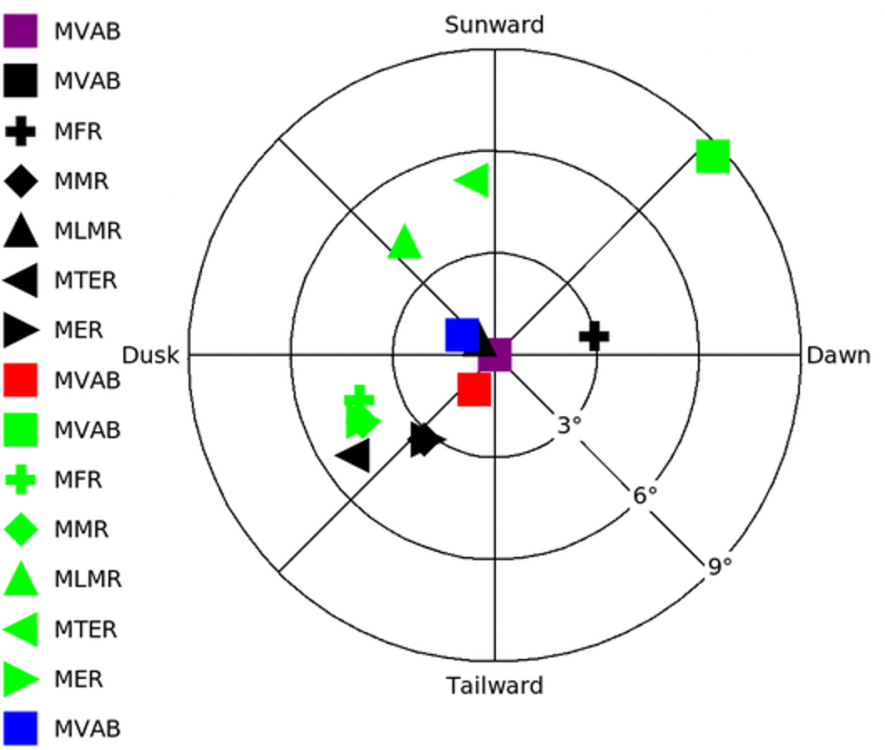
Polar plot of magnetopause normals. The colors represent the four Cluster spacecraft: Black = SC1, red = SC2, green = SC3, blue = SC4; The origin is a normal based on all four spacecraft. Each symbol represents a normal obtained from a particular conservation law: MVAB = conservation of magnetic solenoidality, MFR = conservation of magnetic flux, MMR = mass conservation, MLMR = momentum conservation, MTER = energy conservation, MER = entropy conservation.
Research: Magnetopause PropertiesSection 9
Properties of the Earth’s magnetopause
The magnetopause is a thin sheet of electric current that separates the solar wind from the Earth’s magnetic field. The study of the magnetopause, in particular the orientation, motion, thickness and dynamical processes is one of the prime objectives of the Cluster mission. When a spacecraft traverses the magnetopause, the instruments will record abrupt changes in magnetic field and plasma properties. which can be used to determine these key paramaters.
With Cluster, one can use the timing of the crossings recorded by the four spacecraft to directly determine the orientation and velocity of the magnetopause, and from this calculate its thickness. Together with the known changes in the magnetic field across the current layer one can also compute the net electric current flowing within the magnetopause. The figure below shows such results for a total of 96 Cluster crossings of the dawnside magnetopause.
Particularly striking is the large range of the magnetopause thickness, from less than 200 km to thousands of km. In simple models the magnetopause thickness should scale as the ion gyro-radius, because the gyro radius determines how deep the incident solar wind ions should penetrate the Earth’s magnetic field. But the gyro radius was measured to be only about 50 km for the cases studied. Thus the magnetopause is usually much thicker than simple theory prediicts. Curiously, variations in thickness seemed to be uncorrelated with any properties of the solar wind or the interplanetary magnetic field.
The middle panel demonstrates the large range in magnetopause speeds, from less than 10 to several hundred km/s. This illustrates that one cannot infer the magnetopause thickness simply from the duration of the crossings. The bottom panel, finally, indicates that the current denities are typically 0.1•10-6 Am-2.
These results are documented in
- Paschmann, G., Haaland, S., Sonnerup, B. U. {\”O}., Hasegawa, H., Georgescu, E., Klecker, B., Phan, T. D. ,R{\`e}me, H. and Vaivads, A. : Characteristics of the near-tail dawn magnetopause and boundary layer, Annales Geophysicae, p 1481, 2005
- S.Haaland, B.~U.~{\” O}. Sonnerup, M. W. Dunlop, A. Balogh,H. Hasegawa, B. Klecker,G. Paschmann,B. Lavrau,I. Dandoura,H. R\`eme: Four-Spacecraft Determination of Magnetopause Orientation, Motion and Thickness: Comparison with Results from Single-Spacecraft Methods, Annales Geophysicae, volume 22, 2004
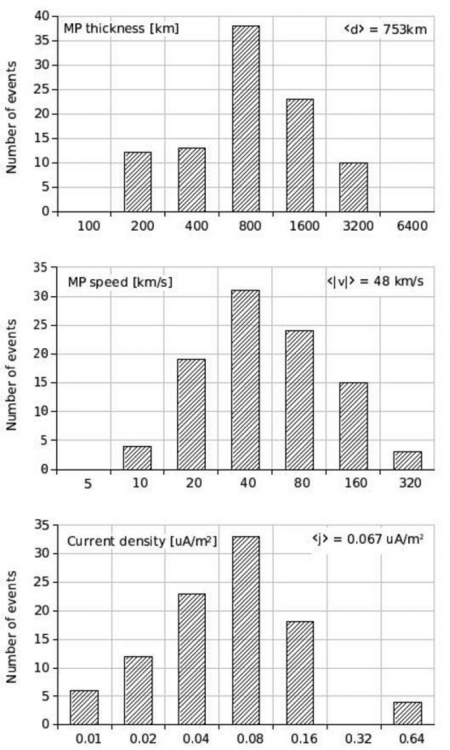
Histograms of magnetopause speed, thickness and current density for number of dawn flank magnetopause crossings by all four Cluster spacecraft on 5 July, 2001.
Research: Magnetopause SoundingSection 10
The dayside magnetopause has been studied taking advantage of the three-dimensional observations provided by the RAPID instrument on Cluster (Wilken et al., 2001). Oksavik et al. (2002) developed a sounding technique using energetic ions to sound the outer edge of Earth’s magnetosphere. From this sounding technique the motion of the magnetopause in three dimensions was determined for the first time. Rapid motions and waves at the magnetopause were detected; even if Cluster were several thousand kilometers away from the boundary. To a large extent the energetic ion sounding technique gives consistent results for all four spacecraft. The ion sounding technique will be developed further as a valuable tool to study boundaries. Knowledge of plasma boundary locations is important for interpreting the physical relevance of other measurements.
These results are documented in two papers:
- Oksavik et al., Three-dimensional energetic ion sounding of the magnetopause using Cluster/RAPID, Geophysical Research Letters, Vol 29, 10.1029/2001GL014265, 2002.
- Wilken et al., First results from the RAPID imaging energetic particle spectrometer on board Cluster, Ann. Geophys., 19, 1355, 2001.
Magnetospheric substorms
The magnetic field at about 20 Re in the magnetospheric tail normally becomes very stretched for about 30 minutes to 1 hour before the start of a substorm. In this period energy is loaded from the solar wind to the magnetosphere. Towards the end of the loading phase, the magnetic field in the tail is so stretched that anti-parallel magnetic field lines from the northern side of the midplane start merging with the field lines on the southern side. In the merging process parts of the energy in the magnetic field is released and transferred to the surrounding plasma, resulting in ion jets out from the merging region.
Understanding the connection between reconnection in the tail and magnetospheric substorms is one of the outstanding questions in magnetospheric physics. These phenomena have been observed a few times earlier by single spacecraft studies (Russell and Elphic, Space Sci. Rev., 22, 681, 1978; Sonnerup et al., J. Geophys. Res., 86, 10049, 1981; Øieroset et al., Nature, 412, 414, 2001). These studies have had clear limitations because it was not possible to distinguish spatial variations from temporal changes. Having four rather closely spaced satellites makes it possible to study the propagation characteristics of the ion jets and how the magnetic field changes. For an event on August 27, 2001, there was an exceptionally good coverage of observations from different parts of the Sun-Earth system. Cluster observed strong ion jets, associated with radical changes in the magnetic field configuration near the midplane of the tail at about 19 Re. A thorough study of the magnetic field and particle distributions at the four Cluster spacecraft shows that the four spacecraft were located very close to the merging region.
The region in the tail observed by Cluster is connected to the auroral zone via magnetic field lines. On the ground we have data available from the Canadian magnetometer network and from photometers at two favourable locations in Canada. We also have available ultraviolet images from the POLAR spacecraft located about 6 Re over the northern auroral zone. These images give a good overview of the global auroral activity in the northern hemisphere, making it possible to study transfer of energy and plasma in the Sun-Earth system associated with auroral events. Results from this study have been reported in Svenes et al. (2002), Stadsnes et al. (2002), and Baker et al. (Geophys. Res. Lett., 29 (24), 2190, 2002).
These results were presented in following presentations:
- Stadsnes et al., Example of a near-Earth reconnection event observed by Cluster, 36th Nordic Plasma and Gas Discharge Symposium, Tromsø, Norway, 2002.
- Svenes et al., Cluster observations in the magnetotail near a reconnection site, Birkeland Symposium, Oslo, Norway, 2002.
72) Förster, M., Y. I. Feldstein, L. I. Gromova. L. A. Dremukhina, A. E. Levitin, and S. E. Haaland, Some aspects of modelling the high-latitude ionospheric convection from Cluster/EDI data, Geomagnetism and Aeronomy, 53 (1), 85-95, 2013.
71) Kronberg, E. A., S. E. Haaland, P. W. Daly, E. E. Grigorenko, L. M. Kistler, M. Fränz, and I. Dandouras, Oxygen and hydrogen ion abundance in the near-Earth magnetosphere: Statistical results on the response to the geomagnetic and solar wind activity conditions, J. Geophys. Res, 117, A12208, doi:10.1029/2012JA018071, 2012.
70) Li, K., S. Haaland, A. Eriksson, M. André, E. EngwalL, Y. Wei, E. A. Kronberg, M. Fränz, P. W. Daly, H. Zhao, and Q. Y. Ren, On the ionospheric source region of cold ion outflow, Geophys. Res. Lett., 39, L18102, doi:10.1029/2012GL053297, 2012.
69) Fear, R. C., S. E. Milan, and K. Oksavik, Determining the axial direction of high-shear flux transfer events: Implications for models of FTE structure, J. Geophys. Res., 117, A09220, doi:10.1029/2012JA017831, 2012.
68) Walsh, B. M., S. E. Haaland, P. W. Daly, E. A. Kronberg, and T. A. Fritz, Energetic electrons along the high-latitude magnetopause, Ann. Geophys., 30, 1003-1013, 2012.
67) Haaland, S., A. Eriksson, E. Engwall, B. Lybekk, H. Nilsson, A. Pedersen, K. Svenes, M. Andre, M. Förster, K. Li, C. Johnsen, and N. Østgaard, Estimating the capture and loss of cold plasma from ionospheric outflow, J. Geophys. Res., 117, A07311, doi:10.1029/2012JA017679, 2012.
66) Haaland, S., B. Sonnerup, and G. Paschmann, More about arc-polarized structures in the solar wind, Ann. Geophys., 30, 867-883, 2012.
65) Snekvik, K., E. Tanskanen, N. Østgaard, L. Juusola, K. Laundal, E. I. Gordeev, and A. L. Borg, Changes in the magnetotail configuration before near-Earth reconnection, J. Geophys. Res., 117, A02219, doi:10.1029/2011JA017040, 2012.
64) Haaland, S., K. Svenes, B. Lybekk, and A. Pedersen, A survey of the polar cap density based on Cluster EFW probe measurements: Solar wind and solar irradiation dependence, J. Geophys. Res., 117, A01216, doi:10.1029/2011JA017250, 2012.
63) Lybekk, B., A. Pedersen, S. Haaland, K. Svenes, A. N. Fazakerley, A. Masson, M. G. G. T. Taylor, and J.-G. Trotignon, Solar cycle variations of the Cluster spacecraft potential and its use for electron density estimations, J. Geophys. Res., 117, A01217, doi:10.1029/2011JA016969, 2012.
62) Vogt, J., Haaland, S., Paschmann, G., Accuracy of multi-point boundary crossing time analysis, Ann. Geophys., 29, 2239-2252, 2011.
61) Anekallu, C. R., M. Palmroth, T. I. Pulkkinen, S. E. Haaland, E. Lucek, I. Dandouras, Energy conversion at the Earth’s magnetopause using single and multispacecraft methods, J. Geophys. Res., 116, A11204, doi:10.1029/2011JA016783, 2011.
60) Förster, M., S. E. Haaland, E. Doornbos, Thermospheric vorticity at high geomagnetic latitudes from CHAMP data and its IMF dependence, Ann. Geophys., 29, 181-186, 2011.
59) Østgaard, N., K. M. Laundal, L. Juusola , A. Aasnes, S. E. Haaland, and J. M. Weygand, Interhemispherical asymmetry of substorm onset locations and the Interplanetary Magnetic Field, Geophys. Res. Lett., 38, L08104, doi:10.1029/2011GL046767, 2011.
58) Kronberg, E. A., R. Bucik, S. Haaland, B. Klecker, K. Keika, M. I. Desai, P. W. Daly, M. Yamauchi, R. Gomez-Herrero, A. T. Y. Lui, On the origin of the energetic ion events measured upstream of the Earth’s bow shock by STEREO, Cluster, and Geotail, J. Geophys. Res., 116, A02210, doi:10.1029/2010JA015561, 2011.
57) Teh, W.-L., B. U. Ö. Sonnerup, G. Paschmann, S. E. Haaland, Local structure of directional discontinuities in the solar wind, J. Geophys. Res., 116, A04105, doi:10.1029/2010JA016152, 2011.
56) Vaivads, A., G. Andersson, S. D. Bale, C. M. Cully, J. De Keyser, M. Fujimoto, S. Grahn, S. Haaland, H. Ji, Yu. V. Khotyaintsev, A. Lazarian, B. Lavraud, I. R. Mann, R. Nakamura, T. K. M. Nakamura, Y. Narita, A. Retino, F. Sahraoui, A. Schekochihin, S. J. Schwartz, I. Shinohara, L. Sorriso-Valvo, EIDOSCOPE: particle acceleration at boundaries, Experimental Astronomy, pp. 1-37, doi:10.1007/s10686-011-9233-6, 2011.
55) Juusola, L., N. Østgaard, E. Tanskanaen, N. Partamies, K. Snekvik, Earthward Plasma Sheet Flows During Substorm Phases, J. Geophys. Res, Vol. 116, A10228, doi:10.1029/2011JA016852, 2011.
54) Juusola, L., N. Østgaard, E. Tanskanaen, Statistics of Plasma Sheet Convection, J. Geophys. Res, Vol. 116, A08201, doi:10.1029/2011JA016479, 2011.
53) Förster, M., Y.I. Feldstein, L.I. Gromova, L.A. Dremukhina, A.E. Levitin, and S. E. Haaland, Plasma convection in the high-latitude ionosphere deduced from Cluster EDI data and the IMF Bx component, Physics of Auroral Phenomena, Vol. 34, ISBN 978-5-91137-182-1, 2011.
52) Jacobsen, K. S., J. I. Moen, and A. Pedersen, Quasistatic electric field structures and field-aligned currents in the polar cusp region, J. Geophys. Res., 115, A10226, doi:10.1029/2010JA015467, 2010.
51) Haaland, S., E. A. Kronberg, P. W. Daly, M. Fränz, L. Degener, E. Georgescu, and I. Dandouras, Spectral characteristics of protons in the Earth’s plasmasheet: statistical results from Cluster CIS and RAPID, Ann. Geophys., 28, 1483-1498, 2010.
50) Sonnerup, B.U.Ö., S. E. Haaland, and G. Paschmann, On arc-polarized structures in the solar wind, Ann. Geophys., 28, 1229-1248, 2010.
49) Jacobsen, K. S., and J. I. Moen, On the correlation between Broad-Band ELF wave power and ion fluxes in the cusp, Ann. Geophys., 28, 1249-1261, 2010.
48) Usanova, M. E., I. R. Mann, Z. C. Kale, I. J. Rae, R. D. Sydora, M. Sandanger, F. Søraas, K.-H. Glassmeier, K.-H. Fornacon, H. Matsui, P. A. Puhl-Quinn, A. Masson, X. Valliéres, Conjugate ground and multisatellite observations of compression-related EMIC Pc1 waves and associated proton precipitation, J. Geophys. Res., 115, A07208, doi:10.1029/2009JA014935, 2010.
47) Kronberg E. A., P.W. Daly, I. Dandouras, S. Haaland and E.Georgescu, Generation and validation of ion energy spectra based on Cluster RAPID and CIS measurements, In ”The Cluster Active Archive: Studying the Earth’s Plasma Environment”, edited by H. Laakso, M. Taylor, and C. P. Escoubet, Springer, ISBN 978-9048134984, 2010.
46) Haaland, S., C. Munteanu, and B. Mailyan, Solar wind propagation delay: Comment on ”Minimum variance analysis-based propagation of the solar wind observations: Application to real-time global magnetohydrodynamic simulations” by A. Pulkkinen and L. Raststätter, Space Weather, 8, S06005, doi:10.1029/2009SW000542, 2010.
45) Blagau, A., B. Klecker, G. Paschmann, S. Haaland, O. Marghitu, and M. Scholer, A new technique for determining orientation and motion of a 2-D, non-planar magnetopause, Ann. Geophys., 28, 753-778, 2010.
44) Förster, M., Y.I. Feldstein, L.I. Gromova, L.A. Dremukhina, A.E. Levitin, and S. E. Haaland, Models of the geomagnetic field and magnetometer measurements of Cluster FGM in the geomagnetic tail, Physics of Auroral Phenomena, Vol. 33, ISBN 978-5-91137-136-4, 2010.
43) Jacobsen, K. S., T. D. Phan, J. P. Eastwood, D. G. Sibeck, J. Moen, V. Angelopoulos, J. P . McFadden, M. J. Engebretson, G. Provan, D. Larson, K.-H. Fornacon, THEMIS observations of extreme magnetopause motion caused by hot flow anomaly, J. Geophys. Res., 114, A08210, doi:1029/2008JA013873, 2009.
42) Lindstedt, T., Yu. V. Khotyaintsev, A. Vaivads, M. André, R. C. Fear, B. Lavraud, S. Haaland, C. J. Owen, Separatrix regions of magnetic reconnection at the magnetopause, Ann. Geophys., 27 (10), 4039-4056, 2009.
41) Haaland, S., B. Lybekk, K. Svenes, A. Pedersen, M. Förster, H. Vaith, and R. Torbert, Plasma transport in the magnetotail lobes, Ann. Geophys., 27, 3577-3590, 2009.
40) Snekvik, K., L. Juusola, N. Østgaard, and O. Amm, Reconnection Hall current system observed in the magnetotail and in the ionosphere, Geophys. Res. Lett., 36, L08104, doi:10.1029/2009GL037239, 2009.
39) Förster, M., Y. I. Feldstein, S. E. Haaland, L. A. Dremukhina, L. I. Gromova, and A. E. Levitin, Magnetospheric convection from Cluster EDI measurements compared with the ground-based ionospheric convection model IZMEM, Ann. Geophys., 27, 3077-3087, 2009.
38) Østgaard, N., K. Snekvik, A. L. Borg, A. Åsnes, A. Pedersen, M. Øieroset, T. Phan, and S. E. Haaland, Can magnetotail reconnection produce the auroral intensities observed in the conjugate ionosphere?, J. Geophys. Res., 114, A06204, doi:10.1029/2009JA014185, 2009.
37) Förster, M., Y. I. Feldstein, S. E. Haaland, L. A. Dremukhina, L.I. Gromova, and A. E. Levitin, Ionospheric convection from Cluster EDI measurements: Comparison with the ground-based IZMEM ionospheric convection model, Physics of Auroral Phenomena, Vol. 32, ISBN: 978-5-91137-101-2, 2009.
36) Mailyan, B., C. Munteanu, A. Reymers, and S. Haaland, Prediction of propagation times of IMF disturbances, Proceedings of International Symposium FORGES-2008, Nor Amberd, Armenia, 2009.
35) Snekvik, K., R. Nakamura, N. Østgaard, S. Haaland, and A. Retinò, The Hall current system revealed as a statistical significant pattern during fast flows, Ann. Geophys., 26 (11), 3429-3437, 2008.
34) Svenes, K. R., B. Lybekk, A. Pedersen, and S. Haaland, Cluster observations of near-Earth magnetospheric lobe plasma densities – a statistical study, Ann. Geophys., 26, 2845-2852, 2008.
33) Förster, M., S. E. Haaland, G. Paschmann, J. M. Quinn, R. B. Torbert, H. Vaith and C. A. Kletzing, High-latitude plasma convection during Northward IMF as derived from in-situ magnetospheric Cluster EDI measurements, Ann. Geophys., 26, 2685-2700, 2008.
32) Takada, T., R. Nakamura, L. Juusola, O. Amm, W. Baumjohann, M. Volwerk, A. Matsuoka, B. Klecker, K. Snekvik, C. J. Owen, A. N. Fazakerley, H. U. Frey, H. Réme, E. A. Lucek and C. Carr, Local field-aligned currents in the magnetotail and ionosphere as observed by a Cluster, Double Star, and MIRACLE conjunction, J. Geophys. Res., 113, A07S20, doi:10.1029/2007JA012759, 2008.
31) Mailyan, B., C. Munteanu, and S. Haaland, What is the best method to calculate the solar wind propagation delay?, Ann. Geophys., 26, 2383-2394, 2008.
30) Haaland, S., G. Paschmann, M. Förster, J. Quinn, R. Torbert, H. Vaith, P. Puhl-Quinn, and C. Kletzing, Plasma convection in the magnetotail lobes: statistical results from Cluster EDI measurements, Ann. Geophys., 26, 2371-2382, 2008.
29) Förster, M., S. Rentz, W. Köhler, H. Liu, and S. Haaland, IMF dependence of high-latitude thermospheric wind pattern derived from CHAMP cross-track measurements, Ann. Geophys., 26, 1581-1595, 2008.
28) Sonnerup, B., S. Haaland, and G. Paschmann, Discontinuity Orientation, Motion and Thickness in “Multi-Spacecraft Analysis Methods Revisited”, G. Paschmann & P. Daly (Eds), ISSI-SR08, ISBN 987-92-9221-937-6, 2008.
27) Pedersen, A., B. Lybekk, M. André, A. Eriksson, A. Masson, F. Mozer, P.-A. Lindqvist, P. M. E. Décréau, I. Dandouras, J.-A. Sauvaud, A. Fazakerley, M. Taylor, G. Paschmann, K. Svenes, K. Torkar, and E. Whipple, Correction to Electron density estimations derived from spacecraft potential measurements on Cluster in tenuous plasma regions, J. Geophys. Res., 113, A07220, doi:10.1029/2008JA013371, 2008.
26) Sharma, A. S., R. Nakamura, A. Runov, E. E. Grigorenko, H. Hasegawa, M. Hoshino, P. Louarn, C. J. Owen, A. Petrukovich, J.-A. Sauvaud, V. S. Semenov, V. A. Sergeev, J. A. Slavin, B.U.Ö. Sonnerup, L. M. Zelenyi, G. Fruit, S. Haaland, H. Malova and K. Snekvik, Transient and localized processes in the magnetotail: a review, Ann. Geophys., 26, 955-1006, 2008.
25) Aasnes, A., M. G. T. Taylor, A. L. Borg, B. Lavraud, R. W H. Friedel, C. P. Escoubet, H. Laasko, P. Daly, A. N. Fazakerely, Multispacecraft observations of electron beam in reconnection region, J. Geophys. Res., 113, A07S30, doi:10.1029/2007JA012770, 2008.
24) Pedersen, A., B. Lybekk, M. André, A. Eriksson, A. Masson, F. S. Mozer, P.-A. Lindqvist, P. M. E. Décréau, I. Dandouras, J.-A. Sauvaud, A. Fazakerley, M. Taylor, G. Paschmann, K. R. Svenes, K. Torkar, and E. Whipple, Electron density estimations derived from spacecraft potential measurements on Cluster in tenuous plasma regions, J. Geophys. Res., 113, A07S33, doi:10.1029/2007JA012636, 2008.
23) Sonnerup, B.U.Ö., S. Haaland, G. Paschmann, M.W. Dunlop, H. Réme, A. Balogh, Correction to ”Orientation and motion of a plasma discontinuity from single-spacecraft measurements: Generic residue analysis of Cluster data”, J. Geophys. Res., 112, A04201, doi:10.1029/2007JA012288, 2007.
22) Förster, M., G. Paschmann, S. E. Haaland, J. M. Quinn, R. B. Torbert, H. Vaith, C. A. Kletzing, High-latitude plasma convection from Cluster EDI: variances and solar wind correlations, Ann. Geophys., 25, 7, 1691-1707, 2007.
21) Snekvik, K., S. Haaland, N. østgaard, H Hasegawa, R. Nakamura, T. Takada, L. Juusola, O. Amm, F. Pitout, H. Réme, B. Klecker and E. A. Lucek, Cluster observations of a field aligned current at the dawn flank of a bursty bulk flow, Ann. Geophys., 25, 1405-1415, 2007.
20) Borg, A. L., N. østgaard, A. Pedersen, M. Øieroset, T. D. Phan, G. Germany, A. Aasnes, W. Lewis, J. Stadsnes, E. A. Lucek, H. Réme and C. Moukis, Simultaneous observations of magnetotail reconnection and bright X-ray aurora on 2 October 2002, J. Geophys. Res., 112, A06215, doi:10.1029/2006JA011913, 2007.
19) Haaland, S., G. Paschmann, M. Förster, J. M. Quinn, R. B. Torbert, C. E. Mcllwain, H. Vaith, P. A. Puhl-Quinn and C. A. Kletzing, High-lattitude plasma convection from Cluster EDI measurements: method and IMF dependence, Ann. Geophys., 25, 239-253, 2007.
18) Haaland, S., G. Paschmann, B.U.Ö. Sonnerup, Comment on ”A New Interpretation of Weimer et al.’s Solar Wind Propagation Technique”, J. Geophys. Res., Vol. 111, A06102, doi:10.1029/2005JA011376, 2006.
17) Sonnerup, B.U.Ö., S. Haaland, G. Paschmann, M. W. Dunlop, H.Réme, A.Balogh, Orientation and motion of a plasma discontinuity from single-spacecraft measurements: Generic residue analysis of Cluster data, J. Geophys. Res., 111, A05203, doi:10.1029/2005JA011538, 2006.
16) Dunlop, M. W., A. Balogh, Q.-Q. Shi, Z. Pu, C. Vallat, P. Robert, S. Haaland, C. Shen, J. A. Davies, K.-H. Glassmeier, P. Cargill, F. Darrouzet, and A. Roux, The Curlometer and other gradient measurements with Cluster, Proceedings of the Cluster and Double Star Symposium – 5th Anniversary of Cluster in Space, ESA SP 598, 2006.
15) Förster, M., S. Haaland, G.Paschmann, J.B.Baker, H.Vaith, J.M.Quinn, R.B.Torbert, Cross-Polar Magnetospheric Plasma Drift as Observedby Cluster EDI: Statistical results, Proceedings of the Cluster and Double Star Symposium – 5th Anniversary of Cluster in Space, ESA SP 598, 2006.
14) Haaland, S., B.U.Ö. Sonnerup, G. Paschmann, E. Georgescu, M.W.Dunlop, A. Balogh, B. Klecker, H.Réme, A.Vaivads, Discontinuity analysis with Cluster, Proceedings of the Cluster and Double Star Symposium – 5th Anniversary of Cluster in Space, ESA SP 598, 2006.
13) Borg, A. L., M. Øieroset, T. D. Phan, F. S. Mozer, A. Pedersen, C. Mouikis, J. P. McFadden, C. Twitty, A. Balogh, and H. Réme. Cluster encounter of a magnetic reconnection diffusion region in the near-Earth magnetotail on September 19, 2003, Geophys. Res. Lett., 32, L19105, doi:10.1029/2005GL023794, 2005.
12) Zong, Q.-G., T. A. Fritz, H. Spence, K. Oksavik, P. Daly, and A. Korth. Energetic particle sounding of the magnetopause – A contribution by CLUSTER/RAPID, J. Geophys. Res., 109, A04207, doi:10.1029/2003JA009929, 2004.
11) Oksavik, K., T. A. Fritz, Q.-G. Zong, F. Søraas, and B. Wilken. Three-dimensional energetic ion sounding of the magnetopause using Cluster/RAPID. Geophys. Res. Lett., 29, 9, doi:10.1029/2001GL014265, 2002.
10) Stenuit, H., M. Fujimoto, S. A. Fuselier, J. A. Sauvaud, S. Wing, A. Fedorov, E. Budnik, S. P. Savin, K. J. Trattner, V. Angelopoulos, J. Bonnell, T. D. Phan, T. Mukai, A. Pedersen, Multispacecraft study on the dynamics of the dusk-flank magnetosphere under northward IMF: 10-11 January 1997, J. Geophys. Res., 107 (A10), 1333, doi:10.1029/2002JA009246, 2002.
9) Gustafsson, G., M. André, T. Carozzi, A. I. Eriksson, C.-G. Fälthammar, R. Grard, G. Holmgren, J. A. Holtet, N. Ivchenko, T. Karlsson, Y. Khotyaintsev, S.Klimov, H. Laakso, P.-A. Lindqvist, B. Lybekk, G. Marklund,F. Mozer, K. Mursula, A. Pedersen, B. Popielawska, S. Savin, K. Stasiewicz, P. Tanskanen, A. Vaivads, and J-E. Wahlund, First results of electric field and density observations by Cluster EFW based on initial months of operation, Ann. Geophys., 19, 1219-1240, 2001.
8) Torkar, K., W. Riedler, C. P. Escoubet, M. Fehringer, R. Schmidt, R. J. L. Grard, H. Arends, F. Rüdenauer , W. Steiger, B. T. Narheim, K. R. Svenes, R. Torbert, M. André, A. Fazakerley, R. Goldstein, R. C. Olsen, A. Pedersen, E. Whipple, and H. Zhao, Active spacecraft potential control for Cluster – implementation and first results, Ann. Geophys., 19, 1289-1302, 2001.
7) Wilken, B., P. W. Daly, U. Mall, K. Aarsnes, D. N. Baker, R. D. Belian, J. B. Blake, H. Borg, J. Büchner, M. Carter, J. F. Fennell, R. Friedel, T. A. Fritz, F. Gliem, M. Grande, K. Kecskemety, G. Kettmann, A. Korth, S. Livi, S. McKenna-Lawlor, K. Mursula, B. Nikutowski, C. H. Perry, Z. Y. Pu, J. Roeder, G. D. Reeves, E. T. Sarris, I. Sandahl, F. Søraas, J. Woch, and Q.-G. Zong. First results from the RAPID imaging energetic particle spectrometer on board Cluster. Ann. Geophys., 19, 1355-1366, 2001.
6) Opgenoorth, H. J., M. Lockwood, D. Alcaydé, E. Donovan, M. J. Engebretson, A. P. van Eyken, K. Kauristie, M. Lester, J. Moen, J. Waterman, H. Alleyne, M. André, M. W. Dunlop, N. Cornilleau-Wehrlin, A. Masson, A. Fazerkerley, H. Réme, R. André, O. Amm, A. Balogh, R. Behlke, P. L. Blelly, H. Boholm, E. Borälv, J. M. Bosqued, S. Buchert, M. Candidi, J. C. Cerisier, C. Cully, W. F. Denig, P. Eglitis, R. A. Greenwald, B. Jackal, J. D. Kelly, I. Krauklis, G. Lu, I. R. Mann, M. F. Marcucci, I. W. McCrea, M. Maksimovic, S. Massetti, P. M. E. Décréau, D. K. Milling, S. Orsini, F. Pitout, G. Provan, J. M. Ruohoniemi, J. C. Samson, J. J. Schott, F. Sedgemore-Schulthess, R. Stamper, P. Stauning, A. Strømme, M. Taylor, A. Vaivads, J. P. Villain, I. Voronkov, J. A. Wild, and M. Wild, Coordinated ground-based, low altitude satellite and Cluster observations on global and local scales during a transient post-noon sector excursion of the magnetospheric cusp, Ann. Geophys., 19, 1367-1398, 2001.
5) André, M., R. Behlke, J.-E. Wahlund, A. Vaivads, A.-I. Eriksson, A. Tjulin, T. D. Carozzi, C. Cully, G. Gustafsson, D. Sundkvist, Y. Khotyaintsev, N. Cornilleau-Wehrlin, L. Rezeau, M. Maksimovic, E. Lucek, A. Balogh, M. Dunlop, P.-A. Lindqvist, F. Mozer, A. Pedersen, and A. Fazakerley, Multi-spacecraft observations of broadband waves near the lower hybrid frequency at the Earthward edge of the magnetopause, Ann. Geophys., 19, 1471-1481, 2001.
4) Pedersen, A., P. Décréau, C.-P. Escoubet, G. Gustafsson, H. Laakso, P.-A. Lindqvist, B. Lybekk, A. Masson, F. Mozer, and A. Vaivads, Four-point high time resolution information on electron densities by the electric field experiments (EFW) on Cluster, Ann. Geophys., 19, 1483-1489, 2001.
3) Lockwood, M., H. Opgenoorth, A. P. van Eyken, A. Fazakerley, J.-M. Bosqued, W. Denig, J. A. Wild, C. Cully, R. Greenwald, G. Lu, O. Amm, H. Frey, A. Strømme, P. Prikryl, M. A. Hapgood, M. N. Wild, R. Stamper, M. Taylor, I. McCrea, K. Kauristie, T. Pulkkinen, F. Pitout, A. Balogh, M. Dunlop, H. Rème, R. Behlke, T. Hansen, G. Provan, P. Eglitis, S. K. Morley, D. Alcaydé, P.-L. Blelly, J. Moen, E. Donovan, M. Engebretson, M. Lester, J. Watermann, and M. F. Marcucci, Coordinated Cluster, ground-based instrumentation and low-altitude satellite observations of transient poleward-moving events in the ionosphere and in the tail lobe, Ann. Geophys., 19, 1589-1612, 2001.
2) Lockwood, M., A. Fazakerley, H. Opgenoorth, J. Moen, A. P. van Eyken, M. Dunlop, J.-M. Bosqued, G. Lu, C. Cully, P. Eglitis, I. W. McCrea, M. A. Hapgood, M. N. Wild, R. Stamper, W. Denig, M. Taylor, J. A. Wild, G. Provan, O. Amm, K. Kauristie, T. Pulkkinen, A. Strømme, P. Prikryl, F. Pitout, A. Balogh, H. Rème, R. Behlke, T. Hansen, R. Greenwald, H. Frey, S. K. Morley, D. Alcaydé, P.-L. Blelly, E. Donovan, M. Engebretson, M. Lester, J. Watermann, and M. F. Marcucci, Coordinated Cluster and ground-based instrument observations of transient changes in the magnetopause boundary layer during an interval of predominantly northward IMF: relation to reconnection pulses and FTE signatures, Ann. Geophys., 19, 1613-1640, 2001.
1) Moen, J., J. A. Holtet, A. Pedersen, B. Lybekk, K. R. Svenes, K. Oksavik, W. F. Denig, E. Lucek, F. Søraas, and M. André, Cluster boundary layer measurements and optical observations at magnetically conjugate sites, Ann. Geophys., 19, 1655-1668, 2001.
Cluster Home
Quicklook Plots
Joint Science Operations Centre


